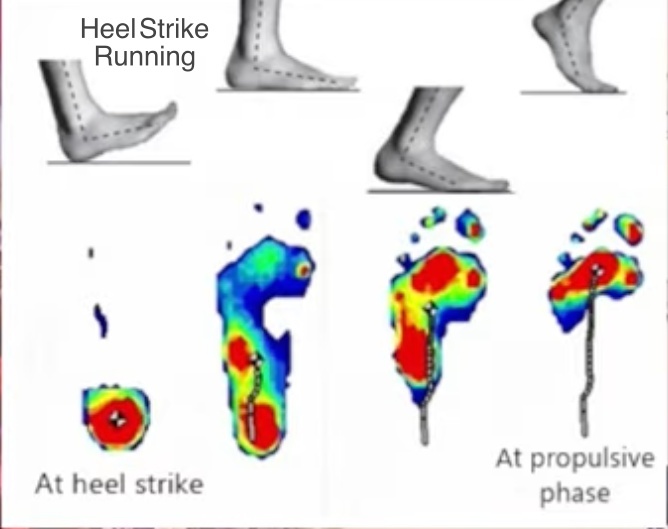In running, high foot arches are thought to be poor shock absorbers because they’re too stiff to undergo the compression needed to attenuate impact. This results in higher initial loading rates and peak impact during stance, and is the reason high-arched runners are more vulnerable to injury, specifically heel injuries and stress fractures. This is especially true if these runners land with a heel strike, but not a forefoot strike!


Generally speaking, research on impact mechanics have found the same basic conclusion in that heel strike running is a significant producer of the impact variables and physical stessors directly responsible for most running injuries, from knee injury to lower back pain to femur fracture.
Due to the high impact nature of heel strike running, a runner with higher arches should consider the most safest, least impact-intensive form of running, which is forefoot running because if they run with a heel strike, the excessive impact will only be amplified.
Why Forefoot is Better for High Arches
Out of all the running styles, forefoot running has the largest positive effect on keeping all forms of impact within a safer range. Forefoot running even eliminates many bone-braking impacts, such as the burst in collisional impact that’s distinctly produced in heel strike running.
Correspondingly, forefoot running significantly reduces the amount of time the foot spends on the ground. In fact, forefoot running results in a contact of the foot with the ground thats so brief that over-pronation (unwanted foot motions) does not have time to occur.
Even more promising, the arch loads differently, in a more functional manner in forefoot running than in heel strike running. Forefoot running engages arch compression which improves the shock absorbing characteristics of the arch, whereas heel strike running causes too much arch deformation, impairing the arches capacity to absorb impact.
- In a forefoot strike landing, the arch undergoes ‘3-point bending’ which prevents arch deformation, and instead, increases arch compression, which is needed for the arch to work better not only as an energy-saving spring, but as a shock absorber, REGARDLESS of arch height!
The big problem with heel strike running is arch compression is impaired because when the bodyweight travels heel-to-toe, the arch actually deforms under the body-weight (shown below).
Worse still, the heavy burst in collisional impact that is always produced at heel strike cannot be absorbed by the arch because of the high rate of deformation makes the arch a sloppy spring and ineffectual shock absorber.
Ultimately, its for these reasons that heel strike running not only prevents the arch from being used more effectively in general, but the arch deformation causes the already high-impacts to be more pronounced with higher arches.
The good news is, in forefoot running, higher arched runners have the potential to run injury-free because the movement path of the foot with the ground is reversed in that the foot doesn’t roll heel-to-toe, rather it rolls forefoot-to-heel (shown below).

The forefoot-to-heel movement path of the foot in forefoot running unlocks the arch in a 3-point bend, allowing the arch to stretch and expand more. This was found to make it easier for the arch to contribute to impact absorption and load up with more elastic strain energy, which is essential in reducing muscle costs!
Best of all, and the biggest takeaway is that in forefoot running, the arch undergoes 3-point bending, making the arch better at absorbing impact, regardless of arch height. This is why a high-arched runner does not produce more impact if they land with a forefoot strike, but running will always be rough and tumble if they heel strike!
References:
Lees at el. Shock absorption during forefoot running and its relationship to medial longitudinal arch height. Foot & Ankle Inter, 2005;26(12) 1080-1088.
Lieberman et al. Foot strike patterns and collision forces in habitually barefoot versus shod runners. Nature, 2010; 463:531-5.
Mølgaard C, Lundbye-Christensen S, Simonsen O. High prevalence of foot problems in the Danish population: a survey of causes and associations. Foot (Edinb). 2010;20(1):7–11.
Williams, DS; McClay-Davies, I; Scholz, JP; Hamill, J; Buchanan, TS: High-arched runners exhibit increased leg stiffness compared to low-arched runners. Gait Posture,
19:263–269, 2004.
Willams et al. Increased medial longitudinal arch mobility, lower extremity kinematics, and ground reaction forces in high-arched runners. J Athl Train, 2014; 49(3):290-296.

If you’d like, you can support Run Forefoot and help keep it going by making a donation in any amount of your choosing:

Or, you can support Run Forefoot by shopping at the BEST Barefoot Shoe Brands, and be sure to bookmark these links 🙂
Saguaro: https://www.saguaro.com/?ref=9bVA8fEkmDvB-I
Vibram FiveFingers: https://www.anrdoezrs.net/click-7600968-11372648
Vivobarefoot: https://amzn.to/3vycQOY
Be Lenka: https://www.dpbolvw.net/click-7600968-14330828
Xero Shoes: https://xeroshoes.com/go/Run_Forefoot
Iguaneye: https://www.iguaneye.com/?ref=8tfXVc92
Soft Star Shoes: https://shrsl.com/3mp1b
Wilding Shoes: https://bit.ly/3lIygQP
Bretta Riches
BSc Neurobiology; MSc Biomechanics candidate, ultra minimalist runner & founder of RunForefoot. I was a heel striker, always injured. I was inspired by the great Tirunesh Dibaba to try forefoot running. Now, I'm injury free. This is why I launched Run Forefoot, to advocate the health & performance benefits of forefoot running and to raise awareness on the dangers of heel striking, because the world needs to know.
Latest posts by Bretta Riches (see all)
- Can You Run In Barefoot Shoes? Yes, But DON’T Heel Strike! - 21/07/2024
- Why Cushioned Running Shoes Are Really Bad for Your Feet - 19/07/2024
- Do Cushioned Running Shoes Cause Injuries? - 17/07/2024

